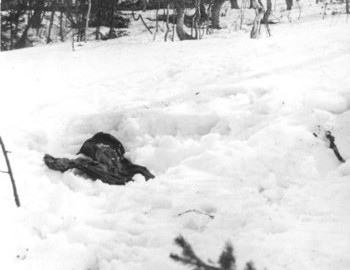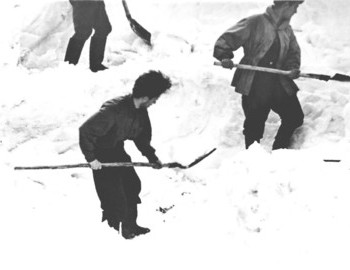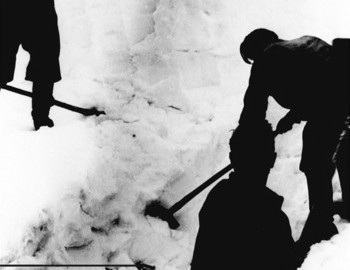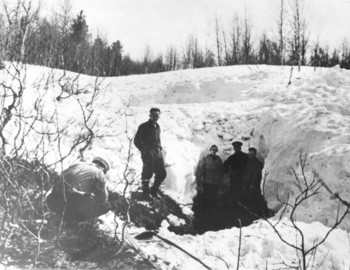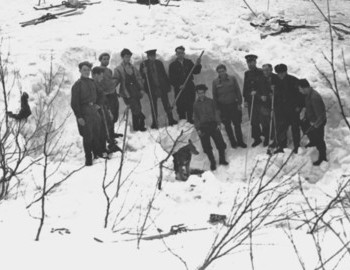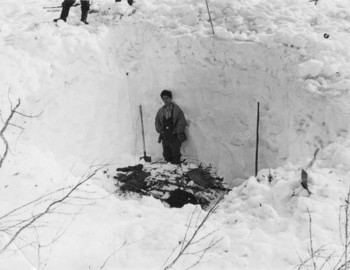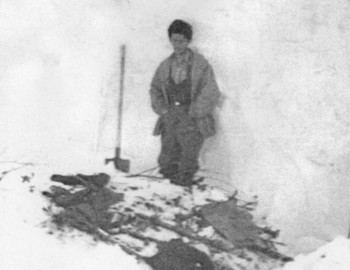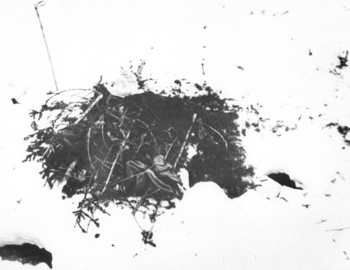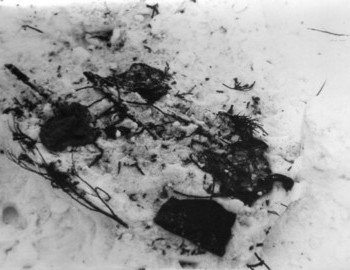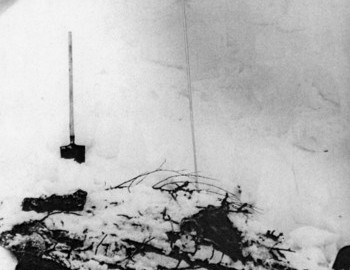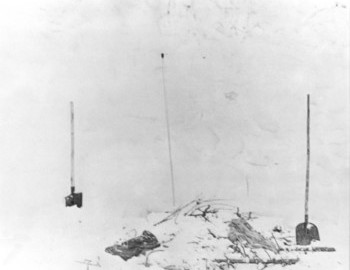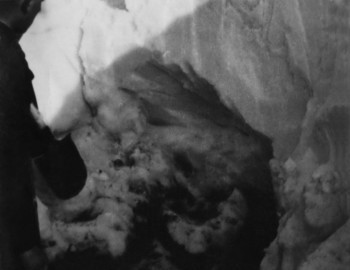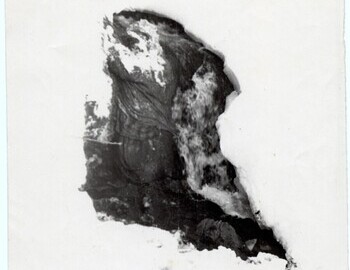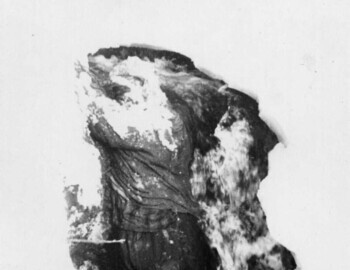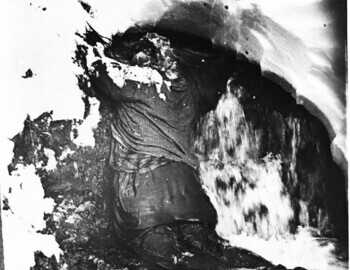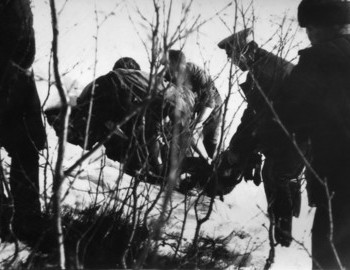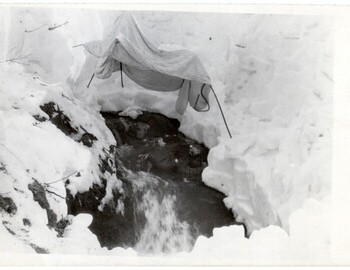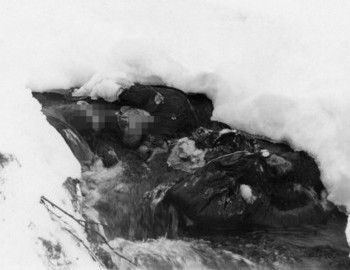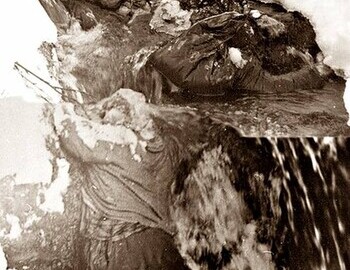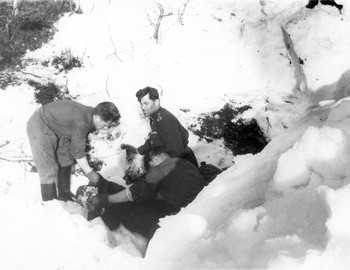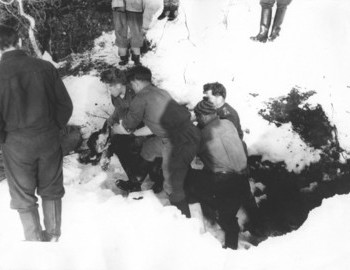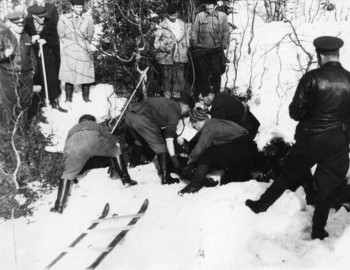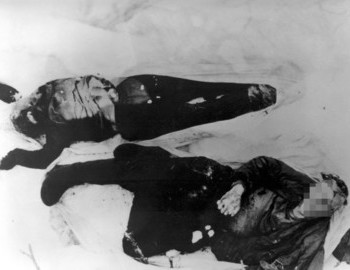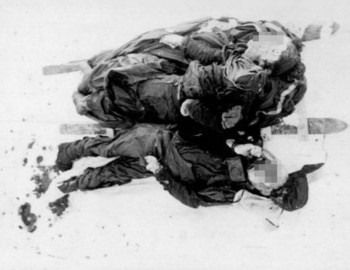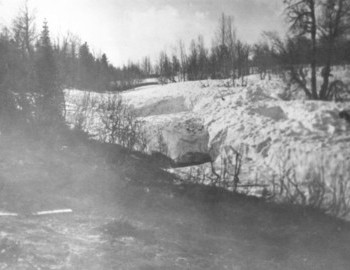
The Den
When in May the snow start melting a Mansi native Kurikov with his dog noticed some cut branches that were forming sort of trail which they followed and 50 m from the cedar they found black cotton sweat pants, the right leg cut off with a knife. Cedar branches, a young fir tree was missing its top, another piece of clothing was found - the left half of the women's light-brown wool sweater, right half and sleeves cut off. Sweater was presumed to belong to Lyudmila Dubinina.
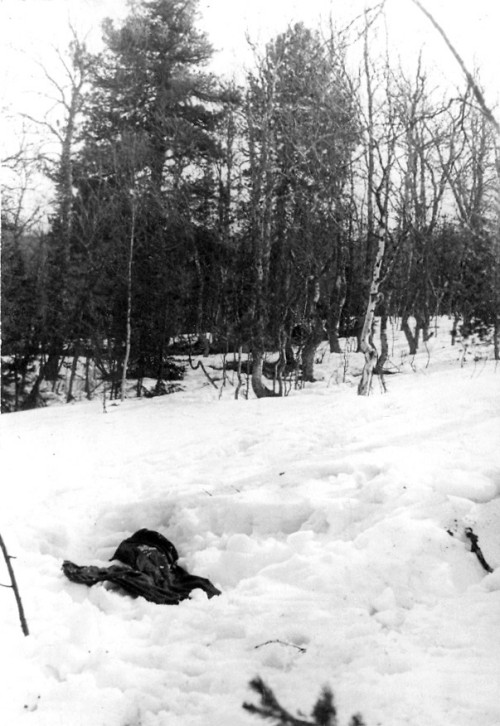
15 m up the bank from the stream, they found half of a beige sweater and the other half of the ski trousers.
The area was previously searched with avalanche probes but the snow then was deeper than expected. Vladimir Askinadzi and Boris Suvorov, both UPI students, were key players in the rescue team. Kurikov followed some small fir tree branches in the snow till 50 m down from the cedar they led into the snowdrift. Rescuers began to dig and at a depth of 3.5 m they found cut branches covered with clothes. The bed of branches consisted of 14 fir tree branches and one birch, and on top were belongings and clothes.

The clothes on a bed of cut branches made 4 seats
The clothes included:
- One leg of a pair of black ski trousers;
- A thick brown woolen sweater;
- A white woolen jumper, made in China; and
- A pair of brown trousers tied at the ankles but flared open with a tear to widen them.
15 m from the den, they found a spoon and a knife sheath. Official criminal investigation, Decision to dismiss criminal case:
“The bodies were found few meters away from the clothes found of Krivonischenko and Doroshenko - pants, sweater. All clothes had been cut when they were taken from the bodies of Doroshenko and Krivonischenko. Bodies of Thibault-Brignoles and Zolotaryov were better dressed, Dubinina’s fur jacket and hat were found on Zolotaryov, her leg was wrapped in woolen trousers that belong to Krivonischenko. Krivonischenko’s knife was found close to the bodies, it was used to cut off branches of young spruce trees."
Here is a very strange fact – knife was never found in the area, only a knife sheath. Lead investigator Lev Ivanov could not have mistaken a sheath for a knife. The branches were cut with tool, that could not be misinterpreted, but the absence of this tool could not be explained without having somebody taken the knife from the crime scene, and that meant that the case could be closed as a “calamity or overwhelming force”.
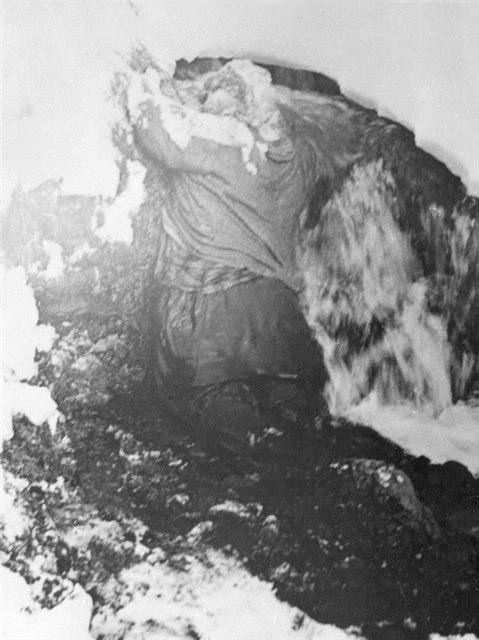
Dying place of Lyudmila Dubinina
20 m from the den, a probe 4 m deep came out with a fragment of flesh. They started to dig. Dubinina's body was found in the ravine on may 5th, 1959. From the official record of the discovery of the bodies:
“On the northwest slope of Hill 880, about 50m from the cedar, in the stream, we have discovered four bodies: three men and one woman. The body of the woman has been identified as Lyudmila Dubinina. The bodies of the men cannot be identified without removing them from the water. They are buried in snow 2.5 m deep. The men are lying with their heads facing north and downstream, and the body of the woman is lying facing upstream. She is dressed in a small skullcap and a yellow sleeveless shirt. Then a flannel shirt; two sweaters, one gray the other dark; and on her legs are leggings and brown ski trousers. On one foot are two woolen socks and, on her right foot is bound half of a beige sweater. On the back of her head and on her back there are traces of damage from our probe. Her body is decaying.
The first man is dressed in a khaki-colored windbreaker, and on his wrist he has two watches, one a Pobeda and the other a Sportif. The Pobeda had stopped at 8:38, and the Sportif showed 8:15. It is not possible to see the head and legs of this body, because he is not completely exposed. The other two bodies lie in a kind of hug, both with nothing on their heads, and some their hair missing. They are both dressed in windbreakers, but it is hard to say what else, and it will have to wait until we get them out of the stream. The bodies are decaying and we have photographed them. They need to be taken out of the stream immediately because they are decaying fast and will soon be lost in the stream, which is very fast.”
It was Vladimir Askinadzi’s probe that damaged Dubinina’s neck. Askinadzi recently published a letter in Ural Pathfinder magazine, in which he recalls that the distance between all the heads of those found in the brook was about 30 cm (about 11.5 “) – they were all very close to each other.
As for Dubinina, he says her head was laying down on a kind of a natural ledge with water rolling over it. Her mouth was open. Dubinina was laying on a kind of a natural ledge with water rolling over it. Her mouth was open. There are claims that the tongue was ripped, or eaten, or whatnot. The medical records simply that "the tongue is missing". Vozrozhdenniy describes missing hypoglossal muscle as well as muscles of the floor of the mouth.

Kolevatov's body (upper left) was found right next to Zolotaryov's as if the latter was carrying or protecting him. Tibo's body was positioned 30 cm lower downstream.
Vladimir Askinadzi recalls that Colonel Ortyukov grabbed the notepad, looked at it, cursed and said: "He’s written nothing." He seems to be the only one that has seen the notepad. The whereabouts of this notepad is unknown, it was never filed in evidence or seen by anyone else. On the other hand we hear only from Askinadzi about the whole episode with the pen, notepad and Colonel Ortyukov, and that 59 years after the fact in a recent letter of Askinadzi to Ural Pathfinder magazine.
Georgiy Ortyukov, the Army Colonel in charge of logistics and helicopter support, was the only one who saw the notebook in Zolotaryov’s hand. Vladimir Askinadzi recalls that it was hard to identify the bodies as they found them, and it was Colonel Ortyukov who was ordaining who was who. ‘We were surprised,’ Askinadzi said, ‘because it was really hard to see, and no one could object or disagree.’
Askinadzi also mentioned that while he was present during that period, he felt very strongly that those in charge were not really interested in a proper investigation. He remembers that the lead investigator Lev Ivanov ‘did not even approach the pad of branches, didn’t take pictures, it seemed they already had a theory’. Askinadzi extends this accusation to Ortyukov, who was in charge of the whole rescue operation. He wrote: ‘If it was really so important to get this right, why didn’t they call for Yuri Yudin? He was the only one that knew them all, and could say for sure. I only knew Zina.’
The whole search operation was rushed. This pressure was from someone above – from Moscow, Sverdlovsk, or Ivdel. The atmosphere was very tense. Everyone was anxious for answers and awaiting for news.
Ortyukov and some soldiers took all the bodies from the stream, carried them up the bank and placed them on special stretchers to drag them across the snow, then took them up to the pass to the helipad. It was hard work, and they repeated the same process four times. A helicopter met them on the pass, but the pilots refused to take the bodies onboard, complaining this was outside their official duties. It has been said that the pilots knew the bodies were poisoned with radiation and, for this reason, didn’t want them in the aircraft. Ortyukov sent the following radiogram:
This is a scandal! I and fourteen other people brought these bodies on our shoulders and they refused to take the bodies in spite of me insisting. As a Communist I am outraged by the behavior of the crew and ask you to inform the Communist Party leader about it. And I have to mention to you for clarity, these bodies are frozen.
We packed them for transportation and there was no reason to refuse to take them. The medical expert refused to examine or to cut the bodies here on site. It is absolutely not dangerous from the point of hygiene. They are folded and covered in special impervious material. The crew said they would not transport them until they are in Zinc coffins.
At this point Colonel Ortyukov reached the limits of his desperation. He took out his pistol and threatened the crew. Vladimir Askinadzi intervened, after which the medical expert reorganized how the bodies should be packed for transportation, and they were finally airlifted for transportation to Ivdel.
Autopsy reports of the hikers found in the Den »

